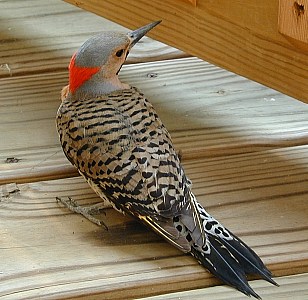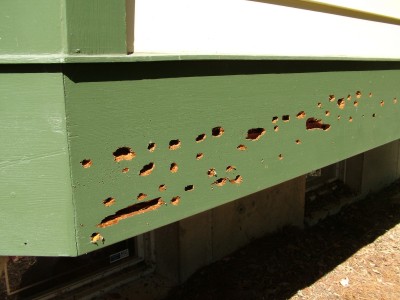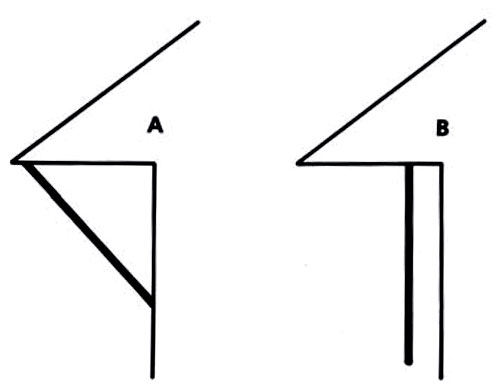 to homes nationwide, the states of Michigan, Louisiana and Wisconsin have estimated the cost of repair to their residences to be in the hundreds of thousands of dollars annually. One survey of woodpecker damage to homes reported an average loss of $300 per incident. Such destruction is rare in urban areas, but it can be extensive in suburban and wooded areas, even where woodpeckers seem to have plenty of natural alternatives to houses. InterNACHI inspectors can assist their clients with some tips to locate and address damage, as well as discourage these sometimes troublesome birds.
to homes nationwide, the states of Michigan, Louisiana and Wisconsin have estimated the cost of repair to their residences to be in the hundreds of thousands of dollars annually. One survey of woodpecker damage to homes reported an average loss of $300 per incident. Such destruction is rare in urban areas, but it can be extensive in suburban and wooded areas, even where woodpeckers seem to have plenty of natural alternatives to houses. InterNACHI inspectors can assist their clients with some tips to locate and address damage, as well as discourage these sometimes troublesome birds.Distinctive Species
Woodpeckers are a subfamily of Picidae birds, known for their long, sticky tongues, which they use for extracting food, and their strong bills, which they use for drilling and drumming on trees. Twenty-one species are found in the United States and many others are found worldwide, with the exception of Australasia and Oceania. Woodpeckers are generally 7 to 15 inches (17 to 40 cm) long, have short legs, sharp-clawed toes and stiff tails. Most woodpeckers feed on wood-boring insects, insects on trees and the ground, vegetable matter, wild berries and tree sap.
Beyond Cosmetic Damage
Much of the damage inflicted to structures is caused specifically by the Northern Flicker (Colaptes auratus),  which can be identified in flight by a yellow or salmon tint under the wings and tail feathers, and a black or red mustache extending from the gape of the beak to below the eyes. The hairy woodpecker (Picoides villosus) and the downy woodpecker (Picoides pubescens) can also be destructive.
which can be identified in flight by a yellow or salmon tint under the wings and tail feathers, and a black or red mustache extending from the gape of the beak to below the eyes. The hairy woodpecker (Picoides villosus) and the downy woodpecker (Picoides pubescens) can also be destructive.
Woodpecker damage, in addition to being problematic in itself, also encourages infestation of insects and other wildlife by providing an entry point into the structure. These same avenues allow rainwater to invade the structure, which can lead to mold growth and other damaging and hazardous conditions.
Wood is not the only building material at risk of attack by woodpeckers. The birds may even pierce plumbing and electrical lines behind a house’s siding. In addition to homes, inspectors and homeowners should be on the lookout for serious woodpecker damage to barns and other outbuildings that are not consistently inhabited or monitored, as well as summer and vacation homes that are vacant for part of the year.
Telltale Signs of Woodpecker Damage
Woodpecker attacks can be categorized into the following general types:
- foraging holes, which may appear as small, deep holes in a nearly straight horizontal or vertical line, or in long trenches of 10 cm or more in length.
 The woodpecker drills these configurations in search of insects. New construction is typically more prone to insect infestation than well-seasoned wood at least two years old;
The woodpecker drills these configurations in search of insects. New construction is typically more prone to insect infestation than well-seasoned wood at least two years old; - drumming holes, appearing as many small, shallow holes in a cluster, or in wider, cone-shaped depressions along the corners or fascia and trim boards of a house. Woodpeckers also drum on metallic surfaces, such as aluminum siding, metal downspouts, gutters, chimneys, vents and antennae poles. A male drums to signal a potential mate by loudly and rapidly tapping on a resonating material during the spring breeding season, although he may drum at other times of the year to announce his claim to a territory. While drumming damage is typically minimal, the noise can be bothersome for building occupants, especially in the early morning when they’re trying to sleep; and
- excavation (nesting or roosting) holes, appearing as deep, round holes 3 to 5cm in diameter. Warm insulation and easily chiseled siding make houses attractive to woodpeckers in search of a place to create a nest for their young. To create its characteristic upside-down L-shaped den, the bird must first get through the siding, sheathing and plywood, creating large, deep holes that account for the most troublesome type of woodpecker damage. Woodpeckers often make several nesting attempts, beginning an excavation only to abandon it and renew the process in a more suitable location. In this fashion, a house may suffer a number of deep holes from the efforts of one determined bird. Nesting holes are excavated at the start of the breeding season, usually from late April into May. Roosting holes are usually built in the late summer and fall in preparation for winter.
Preventing Woodpecker Damage
Fortunately, woodpecker damage can be mitigated through exclusion methods. These methods should be implemented as soon as the bird becomes a pest, as woodpecker behavior patterns are difficult to break once they’ve been allowed to establish.
Inspectors can pass along the following exclusion tips to their clients:
- Place cavity-type nest boxes on buildings in the vicinity of damage. Not on
 ly will this measure encourage woodpeckers to abandon houses for nest boxes, but once there, they will defend their territory and discourage other woodpeckers from approaching. Nest boxes should be shaped and sized for the species of woodpecker that is drilling holes, incorporating a front-sloping, hinged roof to shed rain. Fill the box with sawdust to encourage the bird to excavate it to the desired level. Note that while this measure will discourage woodpecker roosting and nesting, it will not prevent the birds from foraging or drumming on the house.
ly will this measure encourage woodpeckers to abandon houses for nest boxes, but once there, they will defend their territory and discourage other woodpeckers from approaching. Nest boxes should be shaped and sized for the species of woodpecker that is drilling holes, incorporating a front-sloping, hinged roof to shed rain. Fill the box with sawdust to encourage the bird to excavate it to the desired level. Note that while this measure will discourage woodpecker roosting and nesting, it will not prevent the birds from foraging or drumming on the house. - Install some netting. To control bird pests, the University of California's Agriculture and Natural Resources Integrated Pest Management Program recommends placing lightweight, 3/4-inch (1.9 cm) plastic mesh or screen material over the area that woodpeckers may be damaging. Hang the netting from the outside edge of the eave down the side of the house to prevent woodpeckers from reaching the siding. Leave a gap of space of at least 3 inches (7.6 cm) between the mesh and the building's surface so that the birds cannot cause damage through the mesh (see diagrams above right).
- Build with construction materials that do not attract woodpeckers, especially in wooded areas. Clapboard and non-wood siding are best. According to a study conducted by Cornell University, the building material that is most prone to damage is grooved plywood siding, followed by shakes, tongue-and-groove, and board-and-batten.
- Paint wood siding, rather than stain it. The Cornell University study found that stained-wood houses were significantly more prone to woodpecker attack (79% incidence) than painted wood (29%). In the wooded areas surveyed, 97% of the stained houses showed woodpecker damage. Researchers believe that paint is more effective because it fills in the small gaps in wooden siding that can harbor insects upon which woodpeckers feed, and paint is available in light colors, which woodpeckers tend to avoid.
- If it doesn’t pose a safety hazard to people, structures or utility lines, allow dead branches to remain on trees. Branches provide woodpeckers with a place to build nests and forage, limiting their need to use a nearby house for such purposes.
- Apply insecticides or wood preservatives to kill the insects that attract woodpeckers. They will not expend energy searching for insects in an uninfested building.
- If it doesn’t cause structural damage, remove or fill in ledges, cracks and crevices near the site of the woodpecker holes, as these can be used as toeholds for woodpeckers to grasp the structure.
- Deaden or dull the drumming sound caused by woodpeckers by placing insulation or other batting material behind the siding where they peck.
- Cover holes with shiny aluminum flashing. Woodpeckers in search of food or a nesting location will not peck at metal, although they may use it to drum. Holes will also attract other woodpeckers. Do not cover an existing nest, as you will entrap and kill birds already inside.
- Without physically harming them, try to harass or scare the woodpecker using one or more of the following methods:
- a garden hose. You can set the hose at an angle so it can be quickly activated when you hear the drumming sound. The bird will leave immediately and might not return;
- install one or two shaving mirrors attached flat on the wood with the enlarging lens pointing outward to frighten the woodpeckers. Mylar® tape, pie tins and other reflective devices may also be hung around the damage site so that they blow with the wind;
- hang hawk mobiles from the eaves near the damaged area. Construct them from dark cardboard, Styrofoam™ or plywood so that they have a wingspan of about 22 inches (55 cm) and a length of 11 inches (27 cm); and
- make loud noises by banging pots and pans, yelling, or shooting cap guns.
Do Not Try This at Home
Homeowners should avoid the following common yet ineffective or even illegal woodpecker exclusion practices:
- applying chemicals with objectionable tastes or smells. Woodpeckers do not ingest or taste the wood they chisel away with their bills, and they have bristle-like feathers over their nostrils to prevent wood particles from being inhaled. Various chemicals, such as odorous and toxic creosote and pentachlorophenol, have been tested on utility poles to discourage woodpeckers with either no effect or no cost-effectiveness. Naphthalene (mothballs) is also ineffective in outdoor, unconfined settings;
- installing owl effigies or rubber snakes, which provides only temporary relief, according to research conducted by Colorado State University. Note in the photo at right the ineffective owl decoy pictured to the left of a cluster of large woodpecker holes; and
- shooting, poisoning, trapping or killing woodpeckers. Woodpeckers are a federally protected bird under the North American Migratory Bird Act, and lethal action against them requires state and/or federal permits issued by the Law Enforcement Division of the U.S. Fish and Wildlife Service upon the recommendation of USDA-APHIS-Wildlife Services personnel. The unlawful killing of woodpeckers is punishable by fines and incarceration, especially for killing red-cockaded woodpeckers (Picoides borealis) or ivory-billed woodpeckers (Campephilus principalis), which are on the Endangered Species List.
by Nick Gromicko and Rob London
Nick Gromicko, FOUNDER. http://www.nachi.org
International Association of Certified Home Inspectors (InterNACHI) is the world's most elite, non-profit inspection association.
President, ComInspect, www.cominspect.com
Director, Master Inspector Certification Board, www.certifiedmasterinspector.org
Author, 15 books and Co-Host of http://www.NACHI.TV
A note From Judy: If you have a question about buying or selling Real Estate in Fairfield County, and are in need of representation, I invite you to contact me, and if you have an idea for a topic that you would like to see on The CT Realty Blog, please include it in the "Post a Comment" section link below this post. We appreciate the feedback and look forward to providing you with the best real estate content, advice and service in Fairfield County, Connecticut.